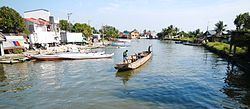Country Philippines Founded 1619 Highest elevation 15 m (49 ft) Local time Wednesday 3:03 PM | District 1st District Barangays Area 46.34 km² Province Bulacan | |
 | ||
Region Central Luzon (Region III) Weather 34°C, Wind S at 6 km/h, 53% Humidity Neighborhoods Masukol, Malumot, Santo Niño, Pinalagdan | ||
Bangkang pinoy sta cruz paombong bulacan
Paombong (Filipino: Bayan ng Paombong; Kapampangan: Balen ning Paombong) is a third class partially urban municipality in the province of Bulacan, Philippines. Dubbed as the "Vinegar Capital of the Philippines", Paombong is famous for its vinegar extracted from the sap of sasa (nipa), thus the term "sukang Paombong" (Paombong vinegar) became known in Luzon and other parts of the Philippines. According to the 2015 census, it has a population of 53,294 people.
Contents
- Bangkang pinoy sta cruz paombong bulacan
- Map of Paombong Bulacan Philippines
- Etymology
- History
- Geography
- Barangays
- Demographics
- Local government
- Municipal officials
- Economy
- Attractions
- Transportation
- Health and Nutrition
- Private schools
- Public schools
- References
Map of Paombong, Bulacan, Philippines
Etymology
Local legend has it that the name "Paombong" was taken from the long bamboo tube called "bumbong" or "tukil" which is used for collecting nipa sap. The practice of extracting nipa sap with bumbongs made the town known as the town with many bumbongs.
The local people claimed that the Spaniards who first visited the place were so amused with the bumbong that, after learning its name from the natives, they named the town after the container, a name which later evolved to Paombong.
History
Paombong was originally one of the visitas (barrio) of Malolos mentioned in Capitulo XXXVI of Conquistas de Las Islas libro segundo by Fray Gaspar San Agustin.In a meeting held in Tondo Convent,the Provincial Chapter created the Town of Malolos in June 1580 with Fray Matheo de Mendoza OSA as its first minister,together with Barrios of Mambog under the patronage of San Roque,Matimbo with Santa Cruz and Paombong with Santiago Apostle de Mayor.In 1619 Augustinians established Paombong Convent but the town was administered by the justice of friars.Paombong is not wealthy as Malolos and Hagonoy at time and it did not sustain its township and it was degraded again as barrio.
In 1639 Paombong was turned over to Calumpit from its mother town Malolos and in 1649 it was returned again to Malolos but on November 28, 1650 it was given its own civil government establishing Paombong its full township with Don Agustin Mananghaya as its first Gobernadorcillo.
In the middle of the 1750s, Paombong grew into a modest community from what was once a cogon land inhabited by a handful of Tagalogs. as its first gobernadorcillo.
During the Revolution against Spain, Paombong’s coastal area, more specifically, Barangays Masukol and Binakod, played a significant role in Philippine History being known encounter sites between Spanish soldiers and Katipuneros. Maloleño General Isidoro "matanglawin" Torres used to retreat with his troops to Barangay Masukol and Barangay Binakod to avoid the advancing Spanish forces. In the latter village, he organized the Katipunan militia of Paombong.
It is from these encounters, in fact, that Barangays Binakod and Masukol earned their present names. In one encounter, Binakod was where the enemies where "fenced in" (binakuran) and it was in Masukol where they were eventually "cornered" (nasukol) and defeated.
In 1898, the first civilian in the person of Don Victorio de Leon headed the Municipal Government until 1900. The seat of the local government was first established at the ground floor of the Paombong Church Convent then popularly called "zaguan". It was later transferred to the house of Numerino Lindayag located in Poblacion, then was transferred to the location of the present Rural Health Center I. Eventually it was moved to the place where it is presently located which since has been the seat of the Municipal Government since then. In 1941, the head of the Municipal Government was later on called Municipal Mayor.
Geography
Paombong is situated south-west of the province of Bulacan, with a total land area of 46.34 square kilometers. It is bounded by the municipality of Calumpit on the north, Malolos City on the east, municipality of Hagonoy on the west and Manila Bay on the south. The municipality is approximately 47 kilometers from Metro Manila, it is a by-pass town and can be accessed via North Luzon Expressway and MacArthur Highway.
Barangays
Paombong is politically subdivided into 14 barangays (6 urban, 8 rural):
Demographics
In the 2015 census, the population of Paombong, Bulacan, was 53,294 people, with a density of 1,200 inhabitants per square kilometre or 3,100 inhabitants per square mile.
Local government
Just as the national government, the municipal government is divided into three branches: executive, legislative and judiciary. The judicial branch is administered solely by the Supreme Court of the Philippines. The LGUs have control of the executive and legislative branch.
The executive branch is composed of the mayor and the barangay captain for the barangays. The legislative branch is composed of the Sangguniang Bayan (town assembly), Sangguniang Barangay (barangay council), and the Sangguniang Kabataan for the youth sector.
The seat of Government is vested upon the Mayor and other elected officers who hold office at the Town hall. The Sanguniang Bayan is the center of legislation.
Municipal officials
The following officials were elected on May 9, 2016 to serve a three-year term.
Economy
Major Industries
Major Products
Attractions
Transportation
Health and Nutrition
There is one hospital operating in Paombong and a main rural health care center unit. The San Pascual Baylon Maternity Hospital, situated at Barangay Sto. Niño that offers secondary healthcare services. And the main rural health care center is one of the district rural health center owned and controlled by the Provincial Government of Bulacan. It offers primary healthcare services which also includes laboratory and dental and maternity services.
Private schools
Public schools
Elementary Schools
High Schools
